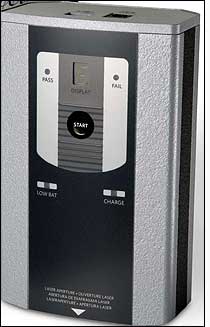Apr 01, 2008Eastman Kodak is marketing its Traceless System to pharmaceutical companies, claiming drugmakers can use it instead of RFID to verify a product is genuine as it passes through the supply chain. The solution is an "ultracovert" marker material applied over drug labels to confirm the authenticity of the bar-code labels on medication packaging.
Several years ago, Kodak developed its Traceless System, which employs a covert substance that is imperceptible to the human eye, but can be detected by a special Kodak optical reader. The company has since offered the system for a variety of authentication applications, including validating wine bottle labels and garment brands. Since 2006, pharmaceutical companies have also used the system as an anticounterfeiting measure on some of their product packaging. Only recently, however, has Kodak offered the system for bar-code authentication as well, in which the bar-code label itself could be validated as a means of thwarting drug counterfeiting.

Pharmaceutical companies and health-care providers alike can use serial bar codes or RFID tags to track the movement of medication as it passes from manufacturing sites through distribution centers and, ultimately, to a drug store or medical facility. An electronic pedigree (e-pedigree) system requires that a drug's identity be verified and recorded at every point through which the product passes, so there is a clear data trail as to where the medicine has been by the time it reaches a patient.
Counterfeiters have found ways to sneak bogus medications into the supply chain, however. Most drug companies use bar-coded labels on their packaging, but such labels can be removed and reapplied to other containers, or copied and reused. RFID tags, though harder to copy, are more expensive than bar-coded labels and require an investment in time to get the RFID system integrated with a company's own management system, as well as attain FDA certification for a new type of packaging.
Kodak has produced what it describes as a better solution that doesn't require investing in new infrastructure, as RFID does, but rather allows bar-coding to be used with greater security. The odorless, colorless Traceless marker can be applied on top of a bar-code or medication label by several bar-code label makers that are working with Kodak to manufacture these labels, says Steve Powell, Kodak Security Solutions' general manager. The marker can also be applied using a thermal transfer ribbon (TTR) that can be dropped into existing thermal printers and printed onto the front of a label—or it can be added to the ink used to print the product labels.
The "traceless" materials are undetectable by other means, and the software's analysis of the visible and invisible images determines whether a label is authentic—that is, whether it matches what the reader is programmed to expect—or fake. Visible information such as bar codes and other patterns can also be processed as part of the authentication process. The system can read through glass, plastic and translucent materials, but requires a clear line of sight.
Pharmaceutical companies can design the system either to send an alert at the time a Kodak reader does not detect a substance on a bar code, or to save that data for later use in the event of forensic evidence, helping determine at which point a spurious product entered the supply chain. Powell says it would be impossible for counterfeiters to copy the proprietary substance Kodak uses, adding, "Our substance is uniquely engineered."
Pharmaceutical manufacturers on several continents have already begun using the solution for bar-code label authentication, Powell notes, though these companies have asked not to be named. Med Health Pharma, a drug repackager in the United States, is also using the Kodak solution but was not able to comment for this article.
Not only does the solution cost less than implementing RFID technology, Powell says, it is also less disruptive since it is simply an add-on to the bar-coding process that nearly every pharmaceutical company is already using.
For that reason, Furukawa says, a solution allowing the continued use of the ubiquitous bar-code labeling might be widely embraced by drug companies and hospitals. However, he adds, "What I worry about is proprietary technology. It locks you into a vendor and doesn't allow you much flexibility." Despite that, he says, "Given that RFID hasn't penetrated the health industry that rapidly, there might be a case for something like this."
Kodak, Powell says, "is not trying to offer a complete e-pedigree solution. We are trying to use what is already in place [bar coding] and make it airtight. Instead of implementing an embryonic technology such as RFID, we're providing an easy way to use 1- or 2-D bar codes with authentication." He adds that, "This is a gap filler as RFID works its way into the mainstream."
Powell estimates the cost at about 1 cent per item when labels are ordered in large quantities (hundreds of millions). The readers and software to operate them are included in that cost, he says. However, says Michael Liard, research director of RFID and contactless technology at ABI Research, the Traceless System's line-of-sight requirement still makes it a more labor-intensive technology than RFID.
"It's a clear sign of innovation against counterfeiting," Liard says, "but you still have the line of sight, and that requires manual scanning. One of the advantages of RFID is reduced labor," since RFID reads do not require personnel to provide a clear line of sight.

